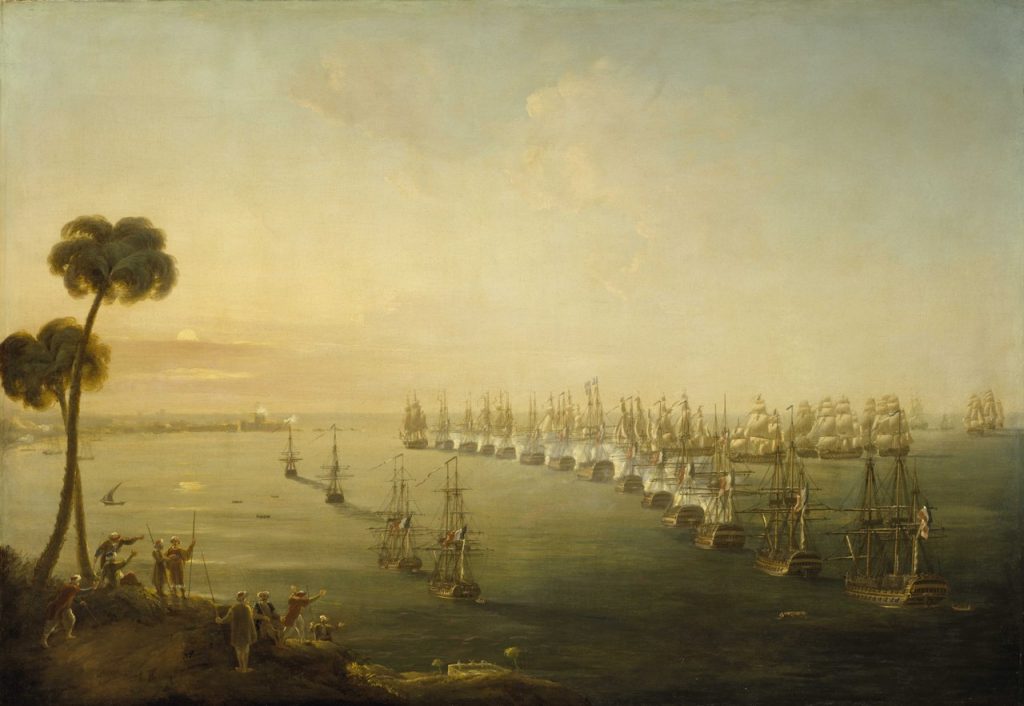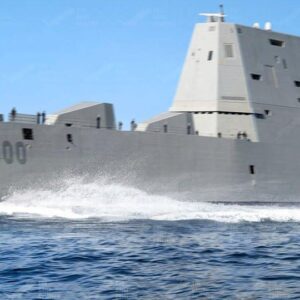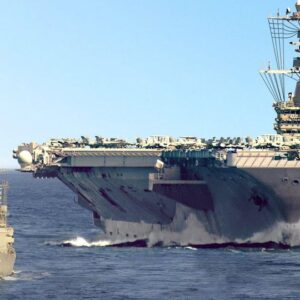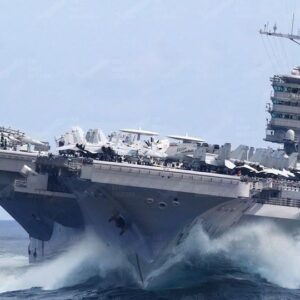The Battle of the Nile, fought between 1-3 August 1798, was a pivotal naval engagement in which the British Royal Navy, under the command of Rear Admiral Horatio Nelson, decisively defeated the French fleet anchored in Aboukir Bay, Egypt.

This victory not only thwarted Napoleon Bonaparte’s ambitions to disrupt British trade in the East but also established British naval dominance during the Napoleonic Wars.
Background
The French Revolution, which began in 1789, radically altered the political and social fabric of France and sent shockwaves across Europe.
The revolution, characterized by its ideals of liberty, equality, and fraternity, challenged the established monarchies and aristocracies of the continent.
It led to the establishment of the French Republic in 1792, which soon found itself at odds with other major powers, including Britain, Austria, Prussia, and Spain.
Amidst this turmoil, a young Corsican artillery officer, Napoleon Bonaparte, rapidly rose through the military ranks.
He distinguished himself as an exceptional military strategist and leader, notably during the Italian Campaign in 1796-1797. By 1798, Napoleon had emerged as one of the most powerful figures in France.
His ambitions extended beyond the European continent; he envisioned a global strategy that would undermine Britain’s growing colonial and commercial power.
Egypt held a position of immense strategic importance. It was the gateway to the trade routes of the Indian Ocean and the Red Sea, vital for the British colonial empire, especially the crown jewel, India.
Control of Egypt would not only weaken British trade but also potentially open a path for French expansion eastwards.
Furthermore, Egypt’s ancient history and culture held a significant allure, making it a prestigious conquest.
Britain, under Prime Minister William Pitt the Younger, was acutely aware of the threat posed by France’s expansionist policies. The British had a global empire to protect, with interests spanning continents.
Their naval strength was the cornerstone of their empire, and any threat to their dominance at sea was taken very seriously. The prospect of a French stronghold in Egypt, threatening the route to India, was unacceptable.
The Mediterranean Sea became a vital arena of conflict. Control of this region was crucial for both the French and British strategies.
The French aimed to extend their influence across the Mediterranean, disrupting British trade and colonial interests, while the British sought to maintain their naval dominance and protect their trade routes.
As Napoleon embarked on his Egyptian Campaign in 1798, the British mobilized to counter this threat. The appointment of Horatio Nelson to lead a fleet to the Mediterranean was a critical decision.
Nelson was already renowned for his skill and aggressiveness as a naval commander.
His pursuit of the French fleet across the Mediterranean was not just a chase but a strategic move in a much larger game of global dominance.
Napoleon’s Arrival In Egypt
Napoleon Bonaparte, by 1798, had established himself as one of Europe’s most formidable military leaders.
His successes in Europe had not only expanded French influence but also brought him into direct conflict with Britain, France’s primary rival.
Napoleon’s strategy was not merely about territorial expansion; it was about weakening Britain’s global hegemony, particularly its maritime and colonial supremacy.
Egypt was a key piece in this puzzle, serving as a potential launching point for further expansion into the Middle East and the Indian subcontinent, thereby threatening British interests.
The Egyptian Campaign was both a military expedition and a scientific endeavor. Napoleon took with him not only soldiers but also a cohort of scientists, engineers, and artists.
This aspect of the campaign highlighted Napoleon’s vision of portraying France as a promoter of knowledge and enlightenment, even while pursuing imperialistic goals.
On their way to Egypt, the French fleet, commanded by Vice-Admiral François-Paul Brueys d’Aigalliers, captured Malta.
This was a strategic move, as Malta was a crucial naval base in the Mediterranean, and its capture allowed the French to secure a critical waypoint to Egypt.
It also sent a strong message about French naval capabilities and intentions in the region.
 The commander of the French fleet, Vice-Admiral François-Paul Brueys d’Aigalliers.
The commander of the French fleet, Vice-Admiral François-Paul Brueys d’Aigalliers.
Upon arriving in Egypt, the French army quickly disembarked and moved towards Alexandria. The capture of Alexandria was crucial for establishing a stronghold in Egypt. Napoleon’s swift action in seizing Alexandria demonstrated his ability to combine naval and ground forces effectively, a hallmark of his military genius.
The French arrival in Egypt caught the British and the Ottoman Empire, the nominal ruler of Egypt, by surprise.
Napoleon had managed to transport an entire army across the Mediterranean without encountering the British fleet, showcasing his strategic acumen and the element of surprise in military operations.
The French presence in Egypt was more than a military threat; it was a challenge to the existing geopolitical order. Egypt was a land of ancient civilizations and immense cultural significance.
By establishing a presence in Egypt, France was not only challenging British power but also asserting itself as a dominant cultural and scientific force in the region.
The initial success of the French in Egypt sent ripples across Europe and the Middle East.
It alarmed the British, who were well aware of the threat it posed to their trade routes and colonial interests.
It also unsettled the Ottoman Empire, which saw its sovereignty over Egypt directly challenged.
Nelson’s Pursuit
Rear Admiral Horatio Nelson was already a celebrated naval commander by 1798, known for his aggressiveness, intuition, and unorthodox tactics. His previous successes had demonstrated a willingness to defy convention and take risks.
Nelson’s leadership style was characterized by his ability to inspire and earn the loyalty of his men, and his acute understanding of naval warfare.
For Britain, naval dominance was not just a matter of pride but a necessity for the survival and prosperity of its empire.
The Royal Navy was the guardian of British trade routes and a key instrument in its colonial ambitions.
When Napoleon’s intentions towards Egypt became clear, it posed a direct threat to British interests, particularly the vital trade route to India.
Nelson’s mission was therefore of the utmost strategic importance.
Nelson’s pursuit of the French fleet was a testament to his tenacity and naval skill.
It involved a great deal of guesswork and intelligence gathering, as the exact whereabouts of the French fleet were unknown.
Nelson had to make decisions based on partial information, often pushing his fleet to the limits of endurance. His pursuit demonstrated not only his commitment to the task but also the capabilities of the Royal Navy.
 Rear-Admiral Sir Horatio Nelson. The aigrette on his hat was gifted to him by the Ottoman Sultan for his victory at the Battle of the Nile.
Rear-Admiral Sir Horatio Nelson. The aigrette on his hat was gifted to him by the Ottoman Sultan for his victory at the Battle of the Nile.
Nelson was known for his tactical innovations. He often eschewed the traditional line-of-battle tactics, favoring more aggressive and direct approaches.
His ability to think differently and adapt his tactics to the situation was a crucial factor in his successes.
This flexibility and innovation were to be key elements in the ensuing Battle of the Nile.
The task of engaging the French fleet was daunting. Not only did Nelson have to locate them in the vast expanse of the Mediterranean, but he also had to engage a fleet that was well-prepared and strategically positioned.
The French were aware of the British pursuit and had the advantage of choosing their battleground.
Naval intelligence and local knowledge played critical roles in Nelson’s strategy. He relied on a network of informants and his own understanding of the Mediterranean, gained through years of naval experience in the region.
This intelligence was crucial in tracking the movements of the French fleet and anticipating their intentions.
Upon nearing the French position at Aboukir Bay, Nelson took time to prepare his fleet, ensuring that his ships were ready for a battle he knew would be pivotal.
His attention to detail, from the condition of his ships to the morale of his men, was a hallmark of his leadership.
The Battle Of The Nile
The French fleet, under the command of Vice-Admiral François-Paul Brueys d’Aigalliers, was anchored in a defensive line off the coast of Aboukir Bay.
The French believed that their position was secure, as it was guarded on one flank by shoals and the coast.
This formation, while seemingly strong, had a critical vulnerability: the gaps between the ships and the fact that the French had not anticipated an attack from the seaward side of their line.
Rear Admiral Nelson, upon encountering the French fleet, quickly assessed the situation and devised a bold plan. Instead of engaging in a traditional parallel line battle, he decided to exploit the gaps in the French line.
He planned to sail some of his ships between the French fleet and the shore, attacking the less protected seaward side of the French ships.
This maneuver was risky and unconventional but had the potential to trap the French fleet and expose their vulnerabilities.
As the British fleet approached in the late afternoon and early evening, Nelson ordered his ships to advance in two lines.
The aim was to cut the French line into three, with the center and rear cut off from the vanguard.
The British ships sailed into the gaps, unleashing broadsides at close range, creating a chaotic and deadly environment for the French.

The French fleet under attack during the Battle of the Nile.
One of the unique aspects of the Battle of the Nile was that much of it was fought at night. Naval battles were typically fought during daylight hours, but the timing of the British attack led to a night engagement.
This added a layer of complexity and confusion to the battle but did not deter the British fleet.
A pivotal moment in the battle was the destruction of the French flagship ‘L’Orient’. Late in the evening of August 1, a fierce exchange of fire resulted in ‘L’Orient’ catching fire.
The fire reached the ship’s magazine, causing a massive explosion. The loss of ‘L’Orient’, along with Admiral Brueys who was mortally wounded, was a severe blow to the French morale and combat effectiveness.
By the morning of August 2, the outcome was clear. The British had achieved a decisive victory, having captured or destroyed most of the French ships. The French fleet was effectively neutralized, leaving Napoleon’s army isolated in Egypt.
The Aftermath
The most immediate and striking outcome of the Battle of the Nile was the establishment of British naval supremacy.
This victory decisively demonstrated the Royal Navy’s superiority in tactics, training, and leadership.
It had far-reaching consequences for the rest of the Napoleonic Wars, as Britain’s control of the seas allowed it to impose blockades, support allies, and project power globally.
British maritime dominance became a central pillar of the nation’s military and economic strength, lasting well into the 20th century.
The defeat at the Nile was a significant setback for Napoleon’s ambitions in the East.
With his fleet destroyed, Napoleon’s army in Egypt was effectively stranded, unable to receive reinforcements or retreat.
While Napoleon achieved some military successes on land, the isolation and eventual withdrawal of his forces from Egypt marked the end of his plans to undermine British influence in the East and establish a French presence in the Middle East and South Asia.
The Battle of the Nile had significant diplomatic repercussions. It bolstered Britain’s standing among European powers and was instrumental in forming the Second Coalition against France, comprising Britain, Russia, the Ottoman Empire, and others.
This new coalition marked a renewed and coordinated effort to counter French expansion, reshaping the geopolitical landscape of Europe.
 The French ship L’Orient explodes during the battle.
The French ship L’Orient explodes during the battle.
Nelson emerged from the Battle of the Nile as a national hero in Britain. His reputation for daring, innovative tactics and inspirational leadership was cemented by this victory.
Nelson’s fame and the adoration he received played a role in bolstering British morale and nationalism during the Napoleonic Wars.
His tactical approach at the Nile influenced future naval strategies and became a studied doctrine in naval warfare.
The victory at the Nile had significant implications for the British Empire, particularly in safeguarding its trade routes and colonial interests.
By thwarting Napoleon’s Eastern ambitions, the Royal Navy ensured the security of the critical trade route to India.
This victory, therefore, played a crucial role in maintaining and expanding the British Empire, particularly in the Indian subcontinent.
The battle captured the public imagination and became a symbol of British resilience and naval prowess.
It was celebrated in art, literature, and popular culture, reinforcing national pride and the image of the Royal Navy as an invincible force.
The psychological impact of such a victory in an era of intense nationalistic fervor cannot be overstated.
The Battle of the Nile also had lasting implications for naval warfare. Nelson’s tactics at the Nile – particularly his bold maneuver of engaging the enemy on both sides and fighting at close quarters – were studied and emulated in subsequent naval conflicts.
The battle demonstrated the importance of innovative tactics, leadership, and the effective use of intelligence in naval warfare.





